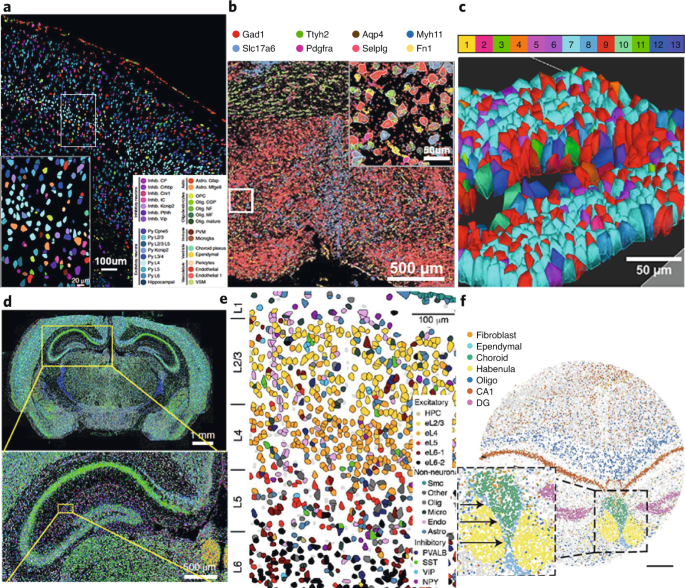
Spatially resolved transcriptomics in neuroscience
- Select a language for the TTS:
- UK English Female
- UK English Male
- US English Female
- US English Male
- Australian Female
- Australian Male
- Language selected: (auto detect) - EN
Play all audios:

One major challenge in neuroscience is to gain a systematic understanding of the extraordinary diversity of brain cell types and how they contribute to brain function. Spatially resolved
transcriptomics holds unmatched promise in unraveling the organization of brain cell types and their relationship with connectivity, circuit dynamics, behavior and disease. Here we discuss
neuroscience applications of various spatially resolved transcriptomics methods, as well as technical challenges that need to be overcome to realize their full potentials. Access through
your institution Buy or subscribe This is a preview of subscription content, access via your institution ACCESS OPTIONS Access through your institution Access Nature and 54 other Nature
Portfolio journals Get Nature+, our best-value online-access subscription $29.99 / 30 days cancel any time Learn more Subscribe to this journal Receive 12 print issues and online access
$259.00 per year only $21.58 per issue Learn more Buy this article * Purchase on SpringerLink * Instant access to full article PDF Buy now Prices may be subject to local taxes which are
calculated during checkout ADDITIONAL ACCESS OPTIONS: * Log in * Learn about institutional subscriptions * Read our FAQs * Contact customer support REFERENCES * Zeng, H. & Sanes, J. R.
_Nat. Rev. Neurosci._ 18, 530–546 (2017). Article CAS Google Scholar * Hodge, R. D. et al. _Nature_ 573, 61–68 (2019). Article CAS Google Scholar * Lake, B. B. et al. _Science_ 352,
1586–1590 (2016). Article CAS Google Scholar * Tasic, B. et al. _Nature_ 563, 72–78 (2018). Article CAS Google Scholar * Zeisel, A. et al. _Science_ 347, 1138–1142 (2015). Article CAS
Google Scholar * Gouwens, N. W. et al. _Cell_ 183, 935–953.e919 (2020). Article CAS Google Scholar * Scala, F. et al. _Nature_ https://doi.org/10.1038/s41586-020-2907-3 (2020). *
Codeluppi, S. et al. _Nat. Methods_ 15, 932–935 (2018). Article CAS Google Scholar * Chen, K. H., Boettiger, A. N., Moffitt, J. R., Wang, S. & Zhuang, X. _Science_ 348, aaa6090
(2015). Article Google Scholar * Moffitt, J. R. et al. _Science_ 362, eaau5324 (2018). Article Google Scholar * Xia, C., Fan, J., Emanuel, G., Hao, J. & Zhuang, X. _Proc. Natl Acad.
Sci. USA_ 116, 19490–19499 (2019). Article CAS Google Scholar * Eng, C. L. et al. _Nature_ 568, 235–239 (2019). Article CAS Google Scholar * Shah, S., Lubeck, E., Zhou, W. & Cai,
L. _Neuron_ 92, 342–357 (2016). Article CAS Google Scholar * Qian, X. et al. _Nat. Methods_ 17, 101–106 (2020). Article CAS Google Scholar * Wang, X. et al. _Science_ 361, eaat5691
(2018). Article Google Scholar * Maynard, K. R., Jaffe, A. E. & Martinowich, K. _Neuropsychopharmacology_ 45, 232–233 (2020). Article CAS Google Scholar * Rodriques, S. G. et al.
_Science_ 363, 1463–1467 (2019). Article CAS Google Scholar * Zhang, M. et al. Preprint at _bioRxiv_ https://doi.org/10.1101/2020.06.04.105700 (2020). * BRAIN Initiative Cell Census
Network (BICCN). Preprint at _bioRxiv_ https://doi.org/10.1101/2020.10.19.343129 (2020). * Xu, S. et al. _Science_ 370, eabb2494 (2020). Article CAS Google Scholar * Kalmbach, B. E. et
al. _Neuron_ 100, 1194–1208.e1195 (2018). Article CAS Google Scholar * Chen, W. T. et al. _Cell_ 182, 976–991.e919 (2020). Article CAS Google Scholar * Chen, X. et al. _Cell_ 179,
772–786.e719 (2019). Article CAS Google Scholar * Petukhov, V., Soldatov, R. A., Khodosevich, K. & Kharchenko, P. V. Preprint at _bioRxiv_ https://doi.org/10.1101/2020.10.05.326777
(2020). * Chen, F. et al. _Nat. Methods_ 13, 679–684 (2016). Article CAS Google Scholar * Liu, Y. et al. _Cell_ 183, 1665–1681.e18 (2020). Article CAS Google Scholar Download
references ACKNOWLEDGEMENTS This work was supported by Allen Institute for Brain Science and by grant U19MH114830 from the National Institute of Mental Health to H.Z. The content is solely
the responsibility of the authors and does not necessarily represent the official views of NIH and its subsidiary institutes. The authors wish to thank the Allen Institute founder, Paul G.
Allen, for his vision, encouragement and support. AUTHOR INFORMATION AUTHORS AND AFFILIATIONS * Allen Institute for Brain Science, Seattle, WA, USA Jennie L. Close, Brian R. Long &
Hongkui Zeng Authors * Jennie L. Close View author publications You can also search for this author inPubMed Google Scholar * Brian R. Long View author publications You can also search for
this author inPubMed Google Scholar * Hongkui Zeng View author publications You can also search for this author inPubMed Google Scholar CORRESPONDING AUTHOR Correspondence to Hongkui Zeng.
ETHICS DECLARATIONS COMPETING INTERESTS The authors declare no competing interests. RIGHTS AND PERMISSIONS Reprints and permissions ABOUT THIS ARTICLE CITE THIS ARTICLE Close, J.L., Long,
B.R. & Zeng, H. Spatially resolved transcriptomics in neuroscience. _Nat Methods_ 18, 23–25 (2021). https://doi.org/10.1038/s41592-020-01040-z Download citation * Published: 06 January
2021 * Issue Date: January 2021 * DOI: https://doi.org/10.1038/s41592-020-01040-z SHARE THIS ARTICLE Anyone you share the following link with will be able to read this content: Get shareable
link Sorry, a shareable link is not currently available for this article. Copy to clipboard Provided by the Springer Nature SharedIt content-sharing initiative
